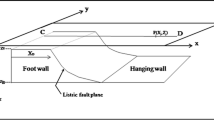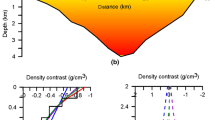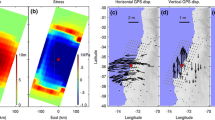Abstract
Conventional gravity inversion techniques have limited ability to quantify structural uncertainty in geologic models. In this paper, a stochastic framework is proposed that directly incorporates fault-related and density-related uncertainty into the inversion process. The approach uses Monte Carlo simulation to generate model realizations and the gradual deformation method to further refine models to match observed data. To guarantee that model realizations are structurally restorable, fault displacements are generated using a kinematic modeling approach in which fault model properties such as the number of faults, location, dip, slip, and orientation are considered uncertain. Using a synthetic case study problem, a reference gravity field was inverted to generate a suite of posterior model realizations. Analysis of the posterior models was used to create a fault probability map as well as quantify the distribution of slip and dip of faults in three zones of deformation. Uncertainty in density values was found to be greatly reduced in the top 250 m depth, suggesting limited sensitivity to deeper sources in this example. Following the synthetic case study problem, the inversion approach was applied to a field-observed gravity profile in Dixie Valley, Nevada, and the inversion results were compared to a previously published forward gravity model. By generating a suite of posterior models, structural uncertainty can be better assessed to make more informed decisions in a host of subsurface modeling problems.

















Similar content being viewed by others
References
Abe S, van Gent H, Urai JL (2011) DEM simulation of normal faults in cohesive materials. Tectonophysics 512(1–4):12–21
Arrowsmith JR, Zielke O (2009) Tectonic geomorphology of the San Andreas Fault zone from high resolution topography: an example from the Cholame segment. Geomorphology 113(1–2):70–81
Athens ND, Glen JMG, Klemperer SL, Egger AE, Fontiveros VC (2016) Hidden intrabasin extension: evidence for dike-fault interaction from magnetic, gravity, and seismic reflection data in Surprise Valley, northeastern California. Geosphere 12(1):15–25
Aydin O, Caers JK (2017) Quantifying structural uncertainty on fault networks using a marked point process within a Bayesian framework. Tectonophysics 712–713:101–124
Barnett JAM, Mortimer J, Rippon JH, Walsh JJ, Watterson J (1987) Displacement geometry in the volume containing a single normal fault. AAPG Bull 71(8):925–937
Beucher H, Renard D (2016) Truncated Gaussian and derived methods. CR Geosci 348(7):510–519
Blakely RJ (1996) Potential theory in gravity and magnetic applications. Cambridge University Press, Cambridge
Breiman L (1999) Random forests. Technical Report TR567. UC Berkeley
Butler DK (1995) Generalized gravity gradient analysis for 2-D inversion. Geophysics 60(4):1018–1028
Caumon G, Tertois AL, Zhang L (2007) Elements for stochastic structural perturbation of stratigraphic models. European Association of Geoscientists & Engineers
Cherpeau N, Caumon G, Lévy B (2010) Stochastic simulations of fault networks in 3D structural modeling. CR Geosci 342(9):687–694
Cockett R, Kang S, Heagy LJ, Pidlisecky A, Oldenburg DW (2015) SimPEG: an open source framework for simulation and gradient based parameter estimation in geophysical applications. Comput Geosci 85:142–154
Crombez V, Hauser J, Peeters L, Chopping R (2020) Understanding the gravity response variability of sedimentary basins using forward stratigraphic modelling. Mar Pet Geol 122:104698
Crook A, Willson S, Yu J, Owen D (2006) Predictive modelling of structure evolution in sandbox experiments. J Struct Geol 28(5):729–744
Exadaktylos GE, Vardoulakis I, Stavropoulou MC, Tsombos P (2003) Analogue and numerical modeling of normal fault patterns produced due to slip along a detachment zone. Tectonophysics 376(1):117–134
Finch E, Gawthorpe R (2017) Growth and interaction of normal faults and fault network evolution in rifts: insights from three-dimensional discrete element modelling. Geol Soc London Special Publ 439(1):219–248
Fullagar P K, Pears G A (2007) Towards geologically realistic inversion. In: Proceedings of exploration ’07, fifth decennial international conference on mineral exploration, Toronto vol. 7, pp 445–460
Gibson JR, Walsh JJ, Watterson J (1989) Modelling of bed contours and cross-sections adjacent to planar normal faults. J Struct Geol 11(3):317–328
Giraud J, Lindsay M, Ogarko V, Jessell M, Martin R, Pakyuz-Charrier E (2019) Integration of geoscientific uncertainty into geophysical inversion by means of local gradient regularization. Solid Earth 10(1):193–210
Godefroy G, Caumon G, Ford M, Laurent G, Jackson CAL (2018) A parametric fault displacement model to introduce kinematic control into modeling faults from sparse data. Interpretation 6(2):B1–B13
Godefroy G, Caumon G, Laurent G, Bonneau F (2019) Structural interpretation of sparse fault data using graph theory and geological rules. Math Geosci 51(8):1091–1107
Goovaerts P (1997) Geostatistics for natural resources evaluation. Oxford University Press, Oxford
Hardy S (2019) Discrete element modelling of extensional, growth, fault-propagation folds. Basin Res 31(3):584–599
Haugerud RA, Harding DJ, Johnson SY, Harless JL, Weaver CS, Sherrod BL (2003) High-resolution lidar topography of the Puget Lowland. Washington. GSA Today 13(6):4–10
Hoffman T, Caers J (2005) Regional probability perturbations for history matching. J Petrol Sci Eng 46(1):53–71
Hollund K, Mostad P, Fredrik Nielsen B, Holden L, Gjerde J, Grazia Contursi M, McCann AJ, Townsend C, Sverdrup E (2002) Havana a fault modeling tool. In: Koestler AG, Hunsdale R (eds) Norwegian petroleum society special publications, vol 11. Hydrocarbon Seal Quantification. Elsevier, Amsterdam, pp 157–171
Hu LY, Blanc G, Noetinger B (2001) Gradual deformation and iterative calibration of sequential stochastic simulations. Math Geol 33(4):475–489
Le Ravalec M, Mouche E (2012) Calibrating transmissivities from piezometric heads with the gradual deformation method: an application to the culebra dolomite unit at the waste isolation pilot plant (WIPP), New Mexico, USA. J Hydrol 472—-473:1–13
Maithya J, Fujimitsu Y, Nishijima J (2020) Analysis of gravity data to delineate structural features controlling the Eburru geothermal system in Kenya. Geothermics 85:101795
Manzocchi T, Carter JN, Skorstad A, Fjellvoll B, Stephen KD, Howell JA, Matthews JD, Walsh JJ, Nepveu M, Bos C, Cole J, Egberts P, Flint S, Hern C, Holden L, Hovland H, Jackson H, Kolbjørnsen O, MacDonald A, Nell PAR, Onyeagoro K, Strand J, Syversveen AR, Tchistiakov A, Yang C, Yielding G, Zimmerman RW (2008) Sensitivity of the impact of geological uncertainty on production from faulted and unfaulted shallow-marine oil reservoirs: objectives and methods. Pet Geosci 14(1):3–15
Martelet G, Perrin J, Truffert C, Deparis J (2013) Fast mapping of magnetic basement depth, structure and nature using aeromagnetic and gravity data: combined methods and their application in the Paris Basin. Geophys Prospect 61(4):857–873
Mosegaard K, Tarantola A (1995) Monte Carlo sampling of solutions to inverse problems. J Geophys Res Solid Earth 100(B7):12431–12447
Nabighian MN, Ander ME, Grauch VJS, Hansen RO, LaFehr TR, Li Y, Pearson WC, Peirce JW, Phillips JD, Ruder ME (2005) Historical development of the gravity method in exploration historical development of gravity method. Geophysics 70(6):63ND-89ND
Nishijima J, Naritomi K (2017) Interpretation of gravity data to delineate underground structure in the Beppu geothermal field, central Kyushu, Japan. J Hydrol Regional Stud 11:84–95
Nollet S, Kleine Vennekate GJ, Giese S, Vrolijk P, Urai JL, Ziegler M (2012) Localization patterns in sandbox-scale numerical experiments above a normal fault in basement. J Struct Geol 39:199–209
Okaya DA, Thompson GA (1985) Geometry of Cenozoic extensional faulting: Dixie Valley. Nevada. Tectonics 4(1):107–125
Pedregosa F, Varoquaux G, Gramfort A, Michel V, Thirion B, Grisel O, Blondel M, Prettenhofer P, Weiss R, Dubourg V, Vanderplas J, Passos A, Cournapeau D, Brucher M, Perrot M, Duchesnay E (2011) Scikit-learn: machine learning in Python. J Mach Learn Res 12:2825–2830
Phelps G (2016) Forward modeling of gravity data using geostatistically generated subsurface density variations. Geophysics 81(5):G81–G94
Phillips JD, Hansen RO, Blakely RJ (2007) The use of curvature in potential-field interpretation. Explor Geophys 38(2):111–119
Remy N, Boucher A, Wu J (2009) Applied geostatistics with SGeMS: a user’s guide. Cambridge University Press
Saltus RW, Blakely RJ (2011) Unique geologic insights from “non-unique” gravity and magnetic interpretation. GSA Today 21(12):4–10.https://doi.org/10.1130/G136A.1
Sambridge M, Gallagher K, Jackson A, Rickwood P (2006) Trans-dimensional inverse problems, model comparison and the evidence. Geophys J Int 167(2):528–542
Scheidt C, Li L, Caers J (2018) Quantifying uncertainty in subsurface systems. Wiley, New York
Sleep NH, Fujita K (1997) Principles of geophysics, vol 550 S453. Blackwell Science, Massachusetts
Souche L, Iskenova G, Lepage F, Desmarest D (2014) Construction of structurally and stratigraphically consistent structural models using the volume-based modelling technology: applications to an australian dataset. In: International petroleum technology conference
Strebelle S (2002) Conditional simulation of complex geological structures using multiple-point statistics. Math Geol 34(1):1–21
Suzuki S, Caers J (2008) A distance-based prior model parameterization for constraining solutions of spatial inverse problems. Math Geosci 40(4):445–469
Thakur M, Blackwell DD, Erkan K (2012) The regional thermal regime in Dixie Valley, Nevada, USA. Geothermal Resources Council Trans 36:59–67
Wellmann JF, Thiele ST, Lindsay MD, Jessell MW (2016) pynoddy 1.0: an experimental platform for automated 3-D kinematic and potential field modelling. Geosci Model Develop 9(3):1019–1035
Woodward NB, Boyer SE, Suppe J (1989) Balanced geological cross-sections. Am Geophys Union Short Courses Geol 6:132
Wooldridge A (2010) Review of modern airborne gravity focusing on results from GT-1a surveys. First Break 28(5):85–92. https://doi.org/10.3997/1365-2397.28.5.38988
Acknowledgements
The authors wish to thank Allegra Hosford Scheirer and three anonymous reviewers whose feedback greatly improved the manuscript.
Author information
Authors and Affiliations
Corresponding author
Rights and permissions
About this article
Cite this article
Athens, N., Caers, J. Stochastic Inversion of Gravity Data Accounting for Structural Uncertainty. Math Geosci 54, 413–436 (2022). https://doi.org/10.1007/s11004-021-09978-2
Received:
Accepted:
Published:
Issue Date:
DOI: https://doi.org/10.1007/s11004-021-09978-2




